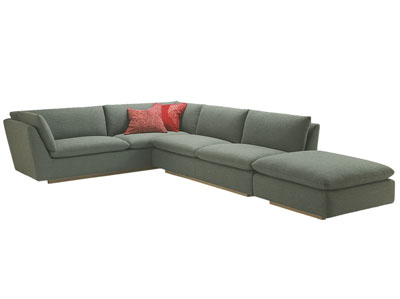Modular sofas give a room more versatility
 Hamburg - A sofa, a love seat and a chair. That's how living room seating has looked for decades.
Hamburg - A sofa, a love seat and a chair. That's how living room seating has looked for decades.
But in times of constant change, the days of such static seating combinations are numbered. Nowadays, flexibility is in demand. Designers have answered by creating modular sofas or sectionals. Customers select the height, width, colour and fabric that meets their individual needs and essentially put the elements together themselves. This individuality is something experts see as crucial.
"On the one hand, we seek a collective experience like being part of a public viewing of something, but at the same time home interiors are becoming ever more individual," said Ursula Geismann of the association representing the German furniture industry in Bad Honnef.
"We want our living spaces to be beautiful and we want to outwardly show it," said professor Peter Wippermann of an organization in Hamburg that charts trends. Individuality and exclusivity in home furnishings raise self-confidence and serve as a means of self expression, said Wipperman in a study commissioned by a German interior design company.
In terms of sofa design, that means customers can play designer at least within preset limits. The furniture makers offer modules in various depths, widths, heights and with or without arms. After selecting the shape and size, the customer chooses from dozens of colours and fabrics.
"Of course, there is a danger that the customer will be overwhelmed," said Geismann. There could be relief in the fact that the trend is going toward a comparatively uniform look.
"The sole use of the cubic, linear form has been exhausted," said Roland Meyer-Bruhl of the German furniture maker Bruhl. Now linear and curved forms are being mixed. At Bruhl the result is Ladybug, said Meyer-Bruhl, describing the line as "living sculpture." It has just a few elements that can be arranged in innumerable ways.
In a similar way, the various modules in a furniture line called Kelp, designed by Studio Vertijet for the German furniture maker Cor, can be set up to create a seating "landscape." Likewise, the Dutch company Montis is offering Domino - a name that practically gives away the look. It involves combining rectangular shaped units in rows, stacked at the corner or combined as islands.
The seat backs of another line, Ponton by the Dutch company Leolux, can be turned so that new seating variations can be created over and over.
The line, Confluences, by French maker Ligne Roset is more like an oversized puzzle. High, low, narrow and wide pieces are placed together depending on the consumer's ergonomic needs. Thus, the consumer, whether he is short or tall - can sit comfortably. Danish furniture maker Fredericia calls its modular work Sercas, a line made of five different elements which provide for many combination possibilities. The sofa can be arranged to be long, narrow, square or cornered, whichever fits best in the living room.
The line, Cable, by the new Dutch label Pode is a casual variation. The soft and cushy-looking chairs and ottomans can be positioned to form combined seating or they can stand alone. Cosmo by German furniture maker Rolf Benz is aimed at a completely different group, but uses a similar principle. It has about three dozens modules that can be combined with others or singularly in the room.
"A sofa has to allow some manoeuvrability for the person who sits on it," said Juergen Hopf, a spokesman for Rolf Benz, referring to the modular trend. There also are entirely practical reasons for it. Consumers are essentially flexible when they have sofas made of individual elements than when their couch is a classic three-sitter, he said. In times when people move around a lot, the couch also has to be transformable so that it can move with its owner and fit in any living space.
In addition to modular styles, new sofas have something else in common - bold colours. Whether the upholstery is leather or fabric, the palette goes from orange and red to purple and turquoise. To emphasize lines, different colours are typically combined within a unit. Equally as common are upholstery mixtures - a leather-covered element next to one with felt, for example. Patterns are largely left out, while decorative elements are mostly embroidery, buttons or tone-on-tone embossing. (dpa)